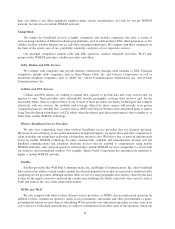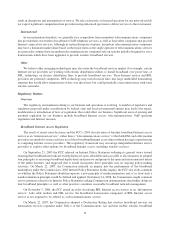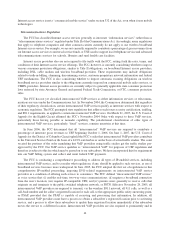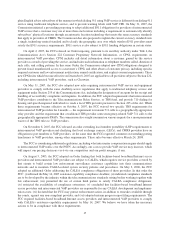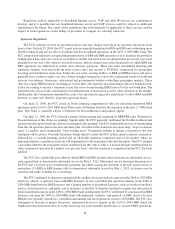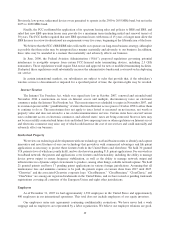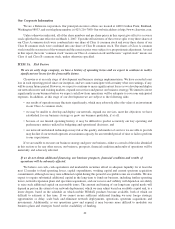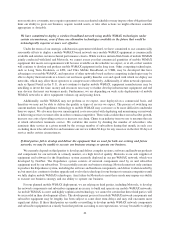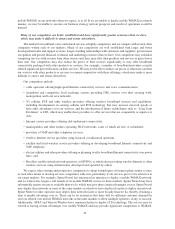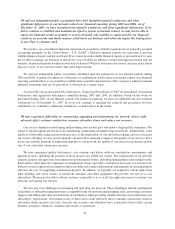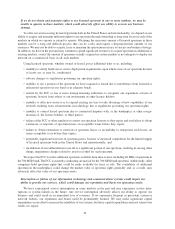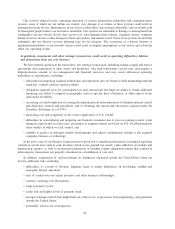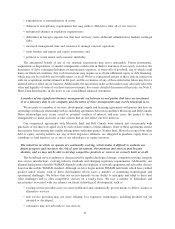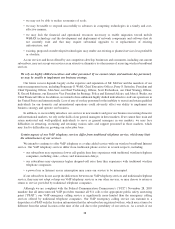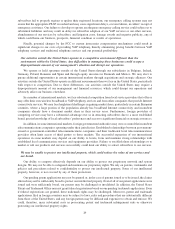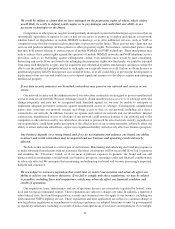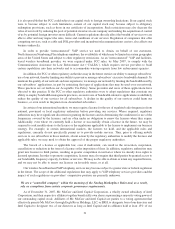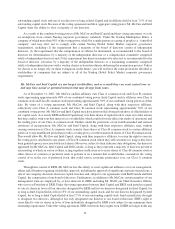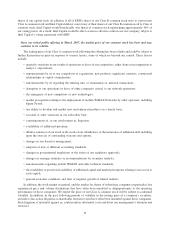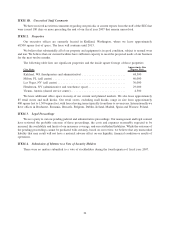Clearwire 2007 Annual Report Download - page 32
Download and view the complete annual report
Please find page 32 of the 2007 Clearwire annual report below. You can navigate through the pages in the report by either clicking on the pages listed below, or by using the keyword search tool below to find specific information within the annual report.We and our independent public accountants have both identified material weaknesses and other
significant deficiencies in our internal control over financial reporting during 2005 and 2006. As of
December 31, 2007, we have remediated our material weaknesses and other significant deficiencies. If we
fail to continue to establish and maintain an effective system of internal control, we may not be able to
report our financial results accurately or to prevent fraud. Any inability to report and file our financial
results in an accurate and timely manner could harm our business and adversely impact the trading price
of our Class A common stock.
We produce our consolidated financial statements in accordance with the requirements of generally accepted
accounting principles in the United States (“U.S. GAAP”). Effective internal controls are necessary to provide
reliable financial reports and prevent fraud. If we cannot provide reliable financial reports or prevent fraud, we may
not be able to manage our business as effectively as we would if an effective control environment existed, and our
business, brand and reputation with investors may be harmed. We have in the past discovered, and may in the future
discover, areas of our internal control that need improvement.
We and our independent public accountants identified material weaknesses in our internal controls during
2005 and 2006. A material weakness is a deficiency or combination of deficiencies in internal control over financial
reporting such that there is a reasonable possibility that a material misstatement of the company’s annual or interim
financial statements will not be prevented or detected on a timely basis.
As more fully discussed in Item 9A of this report, Control and Procedures, in 2007 we remediated our material
weaknesses and significant deficiencies identified during 2005 and 2006. In addition, based on the work we
performed during 2007 on our internal control over financial reporting, we have not identified any new material
weaknesses as of December 31, 2007. If we do not continue to maintain the controls and procedures we have
established, we could have additional weaknesses or deficiencies in the future.
We may experience difficulties in constructing, upgrading and maintaining our network, which could
adversely affect customer satisfaction, increase subscriber churn and reduce our revenues.
Our success depends on developing and providing services that give subscribers a high quality experience. We
expect to expend significant resources in constructing, maintaining and improving our network. Additionally, as the
number of subscribers using our network increases, as the usage habits of our subscribers change and as we increase
our service offerings, we may need to upgrade our network to maintain or improve the quality of our services. If we
do not successfully maintain or implement upgrades to our network, the quality of our services may decline and the
rate of our subscriber churn may increase.
We may experience quality deficiencies, cost overruns and delays with our construction, maintenance and
upgrade projects, including the portions of those projects not within our control. The construction of our network
requires permits and approvals from numerous governmental bodies, including municipalities and zoning boards.
Such entities often limit the expansion of transmission towers and other construction necessary for our network.
Failure to receive approvals in a timely fashion can delay new market deployments and upgrades in existing markets
and raise the cost of completing construction projects. In addition, we typically are required to obtain rights from
land, building and tower owners to install the antennas and other equipment that provide our service to our
subscribers. We may not be able to obtain, on terms acceptable to us or at all, the rights necessary to construct our
network and expand our services.
We also may face challenges in managing and operating our network. These challenges include ensuring the
availability of subscriber equipment that is compatible with our network and managing sales, advertising, customer
support, and billing and collection functions of our business while providing reliable network service that meets our
subscribers’ expectations. Our failure in any of these areas could adversely affect customer satisfaction, increase
subscriber churn, increase our costs, decrease our revenues and otherwise have a material adverse effect on our
business, prospects, financial condition and results of operations.
24


